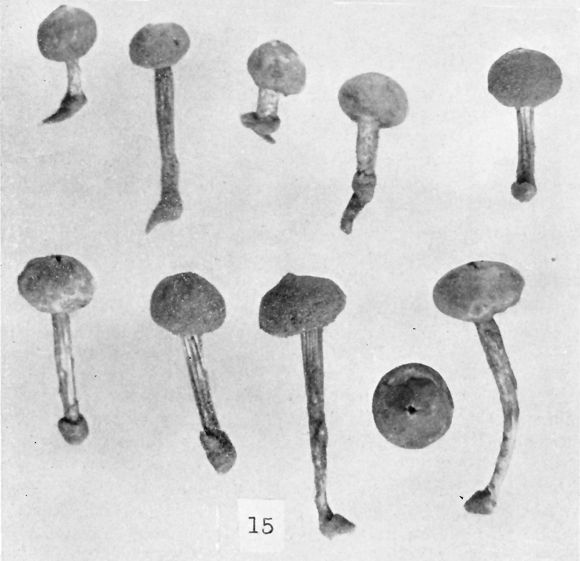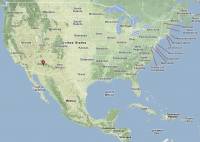
|
|
|
|
Family: Agaricaceae
|
Long, W.H. & Ahmed, S. 1947 Farlowia 3: 248-250. Tylostoma vulgare sp, nov. Figure 15 Latin diagnosis: Sporocarpo subgloboso vel depressogloboso, 8-12 mm- alto, 10-18 mm. lato. Exoperidio granuloso, haud toto secedente, Endoperidio membranaceo, avellaneo; asperato, Ore subfibrilloso vel indefinito. Stipite albicante aetate cinnamomeo, striato vel sulcato, 8-40 mm. alto, 3-6 mm. crasso. Sporis globosis usque ellipticis, 5.4-6.3 µm. Episporio crasso, levi. Sporophore having sporocarp, stipe and slightly bulbous radicating base. Sporocarp subglobose to appressed-globose to pulvinate, 8-12 mm. high by 10-18 mm. wide, firmly attached to stem apex. Exoperidium granular, persistent to deciduous. Peridial sheath a band of hyphae and sand, 3-5 mm. wide, often inconspicuous, persistent. Endoperidium membranous, often pitted around the mouth, avellaneous to wood brown, rough from adhering sand, often entirely covered by the sandy exoperidium. Mouth subfibrillose, with very scanty fibrils when fresh, slightly raised, becoming naked and indefinite as the exoperidium is shed, pitted and finally irregularly lacerate in age. Collar inconspicuous, 1-2 mm. from stem. Stipe dingy white when fresh, then cinnamon on weathering, striate to sulcate, not scaly, even, 8-40 mm. long by 3-6 mm. thick, rarely tapering to base. Radicating base with a strong root 5-8 mm. long. Gleba ferruginous to sayal brown. Capillitium hyaline to yellowish, thick-walled, wavy and irregular, branched, septa rare, little or not swollen. Spores globose to ellipsoid, yellowish, 5.4-6.3 µm, mean 5.7 µm. Epispore thick, smooth. Habitat: Solitary in open sandy wastes which are covered with a scanty scattered growth of perennial grasses; appearing before the grass starts into growth from the monsoon rains. Sheikhupura District, Ladhar, S. Ahmad, April 14, 1938, 153 plants Herb. Ahmad no. 1289, 21 of these now in Herb. Long, no. 11101, type. This is one of the commonest species of the Panjab Plains, Abmad (1939) listed it as Tylostoma australianum Lloyd, so determined by Dr. W. C. Coker, but it is not this species, as a careful comparison with type material showed. Wright J.E. 1987. Bibliotheca Mycologia 113: 212. Tulostoma vulgare Long & Ahmad. (Fig. 152; P1. XXXV:5) - Farlowia 3: 248-250, fig. 15. 1947. Etym.: The name refers to its being very common (in India). Spore-sac up to 15 mm diam, globose-depressed. Exoperidium hyphal, with threads cemented with clay. Endoperidium smooth, papyraceous, fragile, ochraceous. Mouth fimbriate, appearing at first as a nipple, later becoming lacerated and soon becoming indefinite. Socket separated from the stem, conspicuous, membrane entire. Gleba dark ferrugineous. Stem up to 40 x 4 mm, attenuated towards the base, with deep longitudinal- furrows and a distinct volvoid structure and rhizomorphs at the base (radicating base), light coloured, in some specimens straight, in others tapering towards the base (much like in Chlamydopus). Spores subglobose to elliptic, coloured, smooth, guttulate, 4.6-5.4 -(6.8) µm diam; under SEM they also appear perfectly smooth. Capillitium branched, apparently not septate, coloured; threads thick-walled, lumen visible; 3.3-7.4-(8.5) µm diam., provided with pegs. Habitat: clayish soils probably in flooded areas. Distribution: Asia: India, U.S.S.R. North America: United States. Holotype: India: Sheikhupura Distr., Ladhar, leg. S. Ahmad 1289, 14.IV.1938 (Herb. Long 11.101, BPI!). |
|
|
|







